07.11.2022 | Originalien
Durst und Trinken – Physiologie und Bedeutung für die Störungen des Wasserhaushalts
Erschienen in: Journal für Endokrinologie, Diabetologie und Stoffwechsel | Ausgabe 4/2022
Einloggen, um Zugang zu erhaltenZusammenfassung
Hypo- und Hypernatriämien sind die häufigsten Elektrolytstörungen in der täglichen Praxis. Obwohl renale und intestinale Verluste an Wasser bzw. Natrium häufige Ursachen dafür sind, wird der Bedeutung des Trinkverhaltens bei diesen Erkrankungen oft zu wenig Aufmerksamkeit geschenkt. Eine Erhöhung der Osmolalität bzw. der Natriumkonzentration im Serum wird bei Hypernatriämie in verschiedenen Kernen des Hypothalamus detektiert und an zentrale Hirnregionen weitergeleitet, welche ein Durstgefühl auslösen. Umgekehrt kann über dieselben hypothalamischen, aber andere zentrale Regionen des Gehirns nach der Zufuhr von Wasser eine Durstsättigungsgefühl vermittelt werden, was eine übermäßige Zufuhr von Wasser durch Trinken verhindern soll. Störungen in diesen hypothalamischen Strukturen, aber auch habituelle Trinkmuster können diese Regulationsmechanismen beeinflussen und Dysnatriämien auslösen oder verstärken. Eine Hypovolämie wird über Druck- beziehungsweise Volumenrezeptoren im Körper erkannt und über den Hirnstamm an den Hypothalamus weitergemeldet. Auch dieses Signal löst letztendlich ein Durstgefühl aus und erhöht zusätzlich den Appetit auf Salz, beides Maßnahmen, um den Volumenhaushalt wiederherzustellen. Parallel zu der Stimulation oder Inhibition von Durst kann über hypothalamische Kerne auch die Vasopressinsekretion angeregt oder gehemmt und damit die renale Wasserelimination reguliert werden. Trotz dieser renalen Regulationsmuster ist alleine das Trinken die einzige physiologische Möglichkeit, vorhandene Verluste an Wasser auszugleichen.
Anzeige
